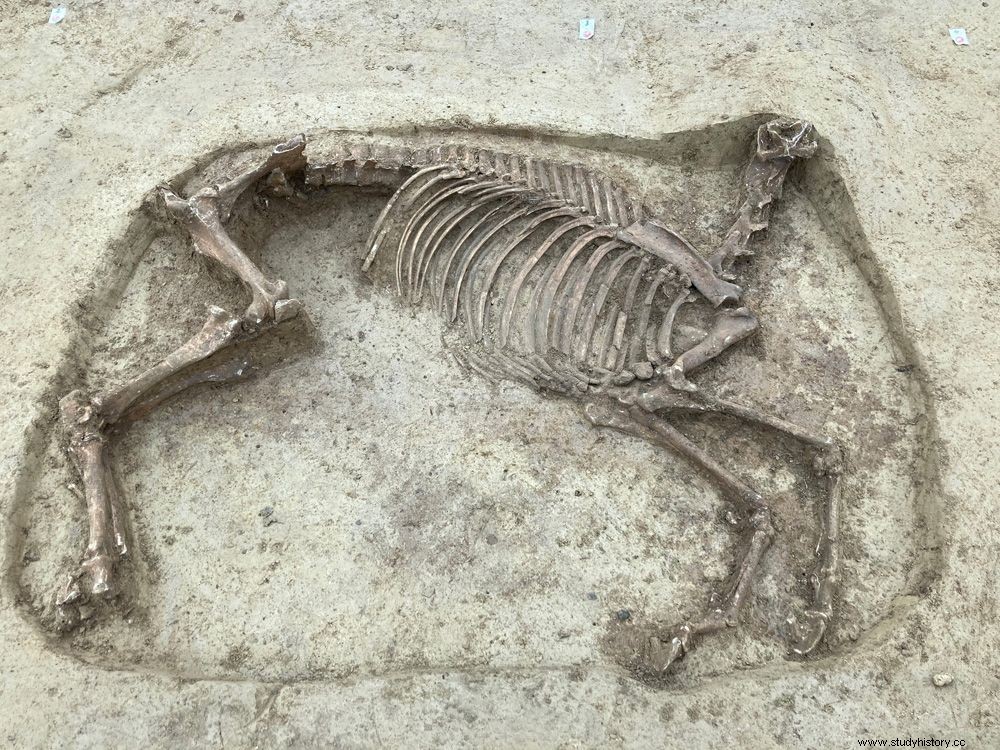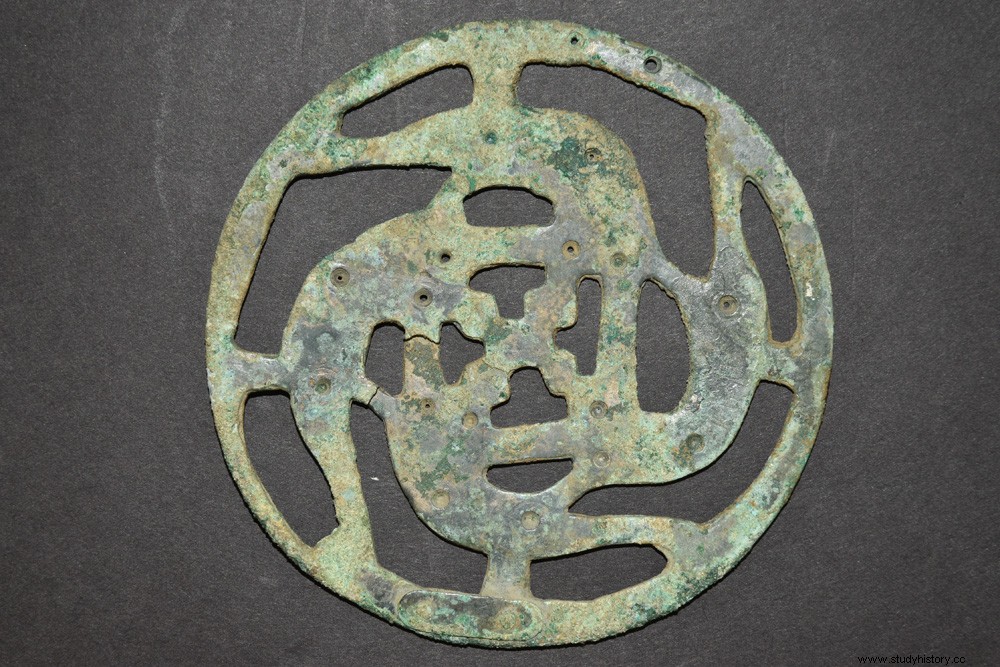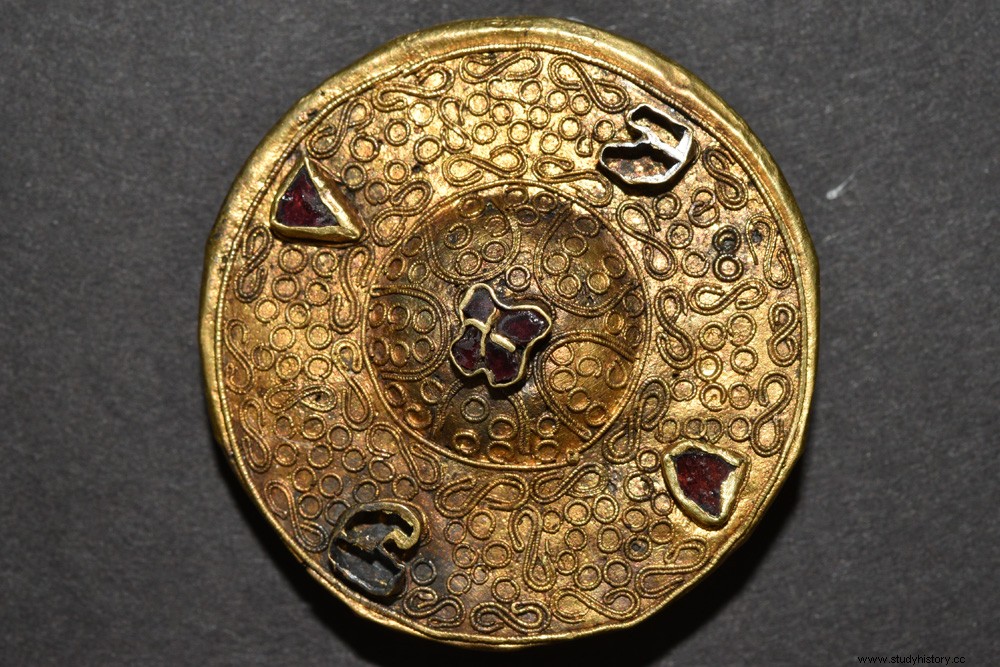What could the spectacular presence of a decapitated horse in a Merovingian necropolis in southern Germany mean? She is no doubt intended to signal the high rank of her master, a warrior who must also have been a landowner.

Burial of a decapitated horse, found in the Merovingian necropolis of Knittlingen
On a site known since 1920, west of the city center of Knittlingen, in the Land of Baden-Württemberg (Germany), exploratory excavations have revealed new burial fields dating from the High Middle Ages. The richness of the artefacts found hints at the high status of the people buried. The presence of a horse, buried very close to its master, is further proof of this, even if the archaeologists of the Land cannot really explain why their head was cut off.
110 burials dating from the early Middle Ages
As its name suggests, the town of Knittlingen has been populated since the Middle Ages:according to toponymy, places whose name ends in -ingen and -heim indeed date back to this period, the first mention of the city appearing around 1100 in the form of "Cnudelingen ". In 1920, construction work on a railway line – which would never be completed – revealed an important burial site to the west of the current city centre. Then, in 1984, new surveys prior to the construction of an important residential area have revealed the presence of tombs in the northern part of the area.Since August 2021, new urbanization plans have given archaeologists the opportunity of the Historical Monuments Service of the Land of Baden-Württemberg to resume the excavations and bring to light new elements.
The excavation campaign is scheduled to last until spring 2022, but for the moment they have already discovered and listed no less than 110 burials dating from the early Middle Ages, the 6th and 7th centuries more precisely. These are aligned tombs, which means that they are arranged in rows, more or less regularly. Some of them, however, are located "outside the row", within a circular grave, a sign that the people who are buried there are part of the elite.
Funeral customs of the Merovingians
At the beginning of the Middle Ages, between the 6th and 9th centuries, the region of Knittlingen was under Frankish domination:the Merovingian dynasty of Frankish kings indeed extended its power over a vast territory, currently corresponding to a large part of France and from Belgium, but also from Germany, Switzerland and the Netherlands. The graves found are in accordance with the funeral customs specific to this period. As was customary among the Merovingians, the bodies unearthed in the necropolis of Knittlingen were both buried in the ground and in funerary chambers – of which only a few pieces of the framework remain today. Some were also buried in wooden coffins.
The dead were dressed
Another custom:the deceased wore their traditional clothes. Despite the looting that occurred from the beginning of the Middle Ages, archaeologists have indeed found many artifacts related to clothing and specific to each gender. The women and young girls were adorned with their jewelry:pearl necklaces, earrings, bracelets, brooches to attach their clothes and belt pendants adorned with decorative discs. Some objects, such as combs or knives, were for everyday use, while others seemed to serve as amulets. In the male tombs, it is the weapons that are ubiquitous:spathas (the broad-bladed Merovingian swords), spears, shields and arrowheads, accompanied by the belts to hold them. In all the burials there were also ceramic containers, most certainly intended to collect the food offerings that accompanied the deceased on their journey, since they still contained animal bones and eggshells.

Decorative bronze disc from a female burial. © Landesamt für Denkmalpflege im Regierungspräsidium Stuttgart / A. Furan
Fashionably dressed women
On a site known since 1920, west of the city center of Knittlingen, in the Land of Baden-Württemberg (Germany), exploratory excavations have revealed new burial fields dating from the High Middle Ages. The richness of the artefacts found hints at the high status of the people buried. The presence of a horse, buried very close to its master, is further proof of this, even if the archaeologists of the Land cannot really explain why their head was cut off.
110 burials dating from the early Middle Ages
As its name suggests, the town of Knittlingen has been populated since the Middle Ages:according to toponymy, places whose name ends in -ingen and -heim indeed date back to this period, the first mention of the city appearing around 1100 in the form of "Cnudelingen ". In 1920, construction work on a railway line – which would never be completed – revealed an important burial site to the west of the current city centre. Then, in 1984, new surveys prior to the construction of an important residential area have revealed the presence of tombs in the northern part of the area.Since August 2021, new urbanization plans have given archaeologists the opportunity of the Historical Monuments Service of the Land of Baden-Württemberg to resume the excavations and bring to light new elements.
The excavation campaign is scheduled to last until spring 2022, but for the moment they have already discovered and listed no less than 110 burials dating from the early Middle Ages, the 6th and 7th centuries more precisely. These are aligned tombs, which means that they are arranged in rows, more or less regularly. Some of them, however, are located "outside the row", within a circular grave, a sign that the people who are buried there are part of the elite.
Funeral customs of the Merovingians
At the beginning of the Middle Ages, between the 6th and 9th centuries, the region of Knittlingen was under Frankish domination:the Merovingian dynasty of Frankish kings indeed extended its power over a vast territory, currently corresponding to a large part of France and from Belgium, but also from Germany, Switzerland and the Netherlands. The graves found are in accordance with the funeral customs specific to this period. As was customary among the Merovingians, the bodies unearthed in the necropolis of Knittlingen were both buried in the ground and in funerary chambers – of which only a few pieces of the framework remain today. Some were also buried in wooden coffins.
The dead were dressed
Another custom:the deceased wore their traditional clothes. Despite the looting that occurred from the beginning of the Middle Ages, archaeologists have indeed found many artifacts related to clothing and specific to each gender. The women and young girls were adorned with their jewelry:pearl necklaces, earrings, bracelets, brooches to attach their clothes and belt pendants adorned with decorative discs. Some objects, such as combs or knives, were for everyday use, while others seemed to serve as amulets. In the male tombs, it is the weapons that are ubiquitous:spathas (the broad-bladed Merovingian swords), spears, shields and arrowheads, accompanied by the belts to hold them. In all the burials there were also ceramic containers, most certainly intended to collect the food offerings that accompanied the deceased on their journey, since they still contained animal bones and eggshells.

Decorative bronze disc from a female burial. © Landesamt für Denkmalpflege im Regierungspräsidium Stuttgart / A. Furan
Fashionably dressed women
Even though much of the artifacts have disappeared due to past looting, these burials clearly indicate that the social status of the deceased was high. This is particularly the case for burials from the second half of the 6th century, such as that of a woman who carried an almost complete bunch of fibulae. A typical practice of this period, says the chief archaeologist of the Land, Folke Damminger, in a press release. While another deceased wore only one gold disc fibula, already prefiguring the fashion of the following century.

Fibula with gold disc, decorated in filigree, from a female burial from the beginning of the 7th century; diameter 3.6 centimeters . © Landesamt für Denkmalpflege im Regierungspräsidium Stuttgart / A. Furan
A rider and his headless horse
While archaeologists are able to tell that some of the men buried were warriors, and more specifically horsemen, they can only speculate as to the presence of a decapitated horse near one of these tombs. As this burial is located "outside the row", they deduce that the horse embodies and shows the social status and value of its master, probably a landowner. Like the objects accumulated in the tomb of the horseman, it therefore most certainly constitutes a funerary offering, intended to prove and perpetuate the status of its owner and his descendants. The animal would have been decapitated on the spot, this act being undoubtedly part of the funeral ritual.
The local elite followed court customs
The furniture also indicates that the people buried in this necropolis were members of the elite:the presence of bronze cups attests, for example, that they followed court customs in table customs. But this impression of wealth is beginning to fade in the burials dating from the end of the 7th century. Archaeologists note that they contain more modest offerings. Is this a sign that the local elite is no longer as prosperous, or that burials are no longer following the same ritual and are becoming more austere?
From 639, with the death of the Frankish king Dagobert I, the power of the Merovingians began to decline in favor of the high dignitaries of the kingdom, the mayors of the palace. It was one of them, Pepin the Short, who seized power in 751. The Merovingian kings then gave way to the Carolingian dynasty. Under their reign, Christianity spread to the countryside and brought about a change in funeral practices. Dressed burial and offerings in tombs will then become rare, before being banned as pagan practices.
